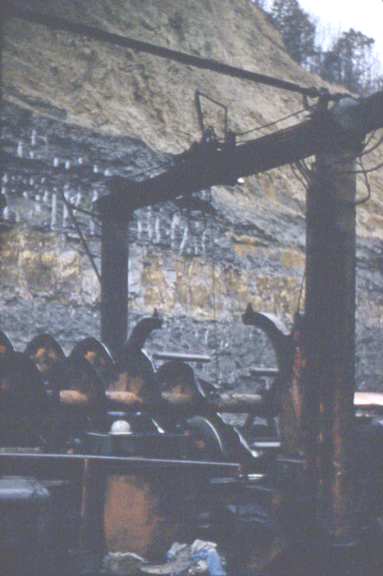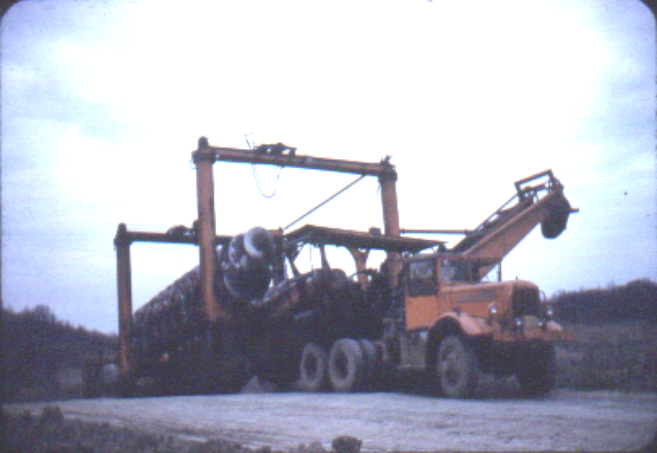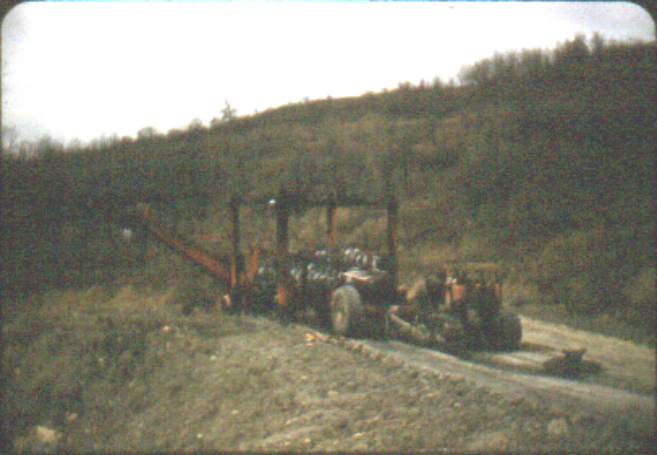Chapter
30
Coal II
Before
Compton made the offer on the Lost Creek farm, R. N. White stripped
the Jesse Run farm. He made us a reasonable offer, was a good
communicator, and did a competent job. It considerably improved the
farm from the back filling job Yochym Brothers Coal had done for
Carroll Bond a few years before we bought the farm. Much of the
upper level had coal on it after Yochym , and only the most miserable
weeds would grow there, if anything would grow at all – typical of
soil with coal in it.
(Illustration
30-1)
T
 he
pictures in this chapter and the previous one are slides taken in
1956 resuscitated fifty years later. I have tried to optimize the
detail rather than the color. They were taken on the strip job where
I worked in the summer of 1952, discussed elsewhere in this book.
They show details of the Compton Coal Auger which I was not able to
show with more recent pictures in the next chapter.
he
pictures in this chapter and the previous one are slides taken in
1956 resuscitated fifty years later. I have tried to optimize the
detail rather than the color. They were taken on the strip job where
I worked in the summer of 1952, discussed elsewhere in this book.
They show details of the Compton Coal Auger which I was not able to
show with more recent pictures in the next chapter.
This is an auger being moved,
taken to show the size of the machine relative to the height of the
“highwall,” the vertical face of the hill left when the coal is
stripped by the conventional stripping method.
Mr.
White had a very pleasant wife and two daughters. The older of the
two told partner Ward Maxson and me she wanted to become a
professional football player. He used Caterpillar D-9 dozers and two
huge end loaders to move rocks and dirt. I remember his telling me
the tires of the end loaders were filled with barium sulfate powder,
because it had high density. Loading them with calcium chloride
solution, like farm tractor tires, would not provide enough weight.
Each tire had 1800 pounds of barium sulfate in it. These loaders
were huge, much too large to use loading a truck that would run on
the road. They were for moving dirt and broken rock.
When
the job was finished, Mr. White offered to fly Esther and me down
from Kent, Ohio, where I was in graduate school, in his personal
plane, to approve the backfilling, as prescribed by law. I said we
would have to go over it on the ground, because I couldn’t tell
from the air. We started in early afternoon, flew to Bridgeport,
piloted by Jack Lambert, White’s assistant, and came out to the
farm in his Jeep station wagon to look over the job. There wasn’t
much that could be done to improve it at acceptable cost. I knew
that before the journey started. We (Esther and I) flew back to Kent
the same afternoon. Such was the luxurious methods of the strip
mining industry at the time.
Actually,
the stripping ended early. A little more than halfway through, Mr.
White found a better money making opportunity elsewhere, and left
without taking out the most deeply covered coal, but he told me how
much was left. He was operating on a big scale but later got in
trouble, went broke, and was set up in business again by the Mafia.
(At least that was the rumor, the Mafia played a part in West
Virginia coal business and in about anything else that made big
money).
Going
back to the Lost Creek farm now. As mentioned above, one by-product
of the venture with Compton on the Lost Creek farm was the discovery
that our title to the Redstone Coal was not clear. Their lawyer,
(Jim Christie) had searched the title and claimed that the Redstone
belonged to the Hutchinson heir, who at this point was a Colonel
Meyers.
(Illustration
30-2)

Method of movement. The truck supports one end, the
other end drags and is pushed by a bulldozer. See next picture.
This
upset me greatly. After learning about Christie’s claim, I went to
the courthouses in Harrison County, Marion County, and South to Logan
County. I researched the Fairmont newspaper for details of the
Hutchinson company and family and so pretty much got the whole
history of the company. It ran out quickly after Hutchinson died.
But I did not find anything that would help our claim.
I
was sure Dad had been paid for the Redstone (in addition to the
stripping rights) when Don Harrold took it out but had no
documents to prove it. And I was reasonably sure he had been paid
when L. E. Cleghorn stripped the first time, but again I had no
documentary proof. Meyers and his predecessors had not paid coal tax
on the Redstone, ever, for the 66 years Christie said it was in their
possession. That was clear from the records at the courthouse. Then
several years after Sunny Rogers
(Illustration
30-3)

Dozer pushing coal auger to
move it. See above.
died,
Ruth, his widow, sent the old files concerning Don Harrold to Mom.
They very clearly showed that Dad had been paid for the Redstone
coal.
There
is a provision in the law in settling an argument over ownership that
runs like this: A property owner must act like an owner. Very
clearly, the Hutchinson heirs had not been acting like they owned the
coal if they let someone else sell it and hadn’t paid tax for 66
years.
George
Fordham, a lawyer in Clarksburg, took the case, and with help of Pat
Deem of Steptoe and Johnson asked the Circuit Court to declare the
Bond family the rightful owners. Meyers signed a Quit Claim
(admitting he had no claim to the coal) when confronted with the
evidence and the law on the matter. (He didn’t need the money any
way – he lived in great comfort, and had made generous donations to
charity.) The cost to us was small relative to the royalty that came
from it. Mr. Fordham could probably have done it, but Mr. Deem
carried great weight in the natural resource community, and that
prevented Steptoe and Johnson from entering the case on the opposite
side, because of conflict of interest.
The
family let me have five percent for the work I had done, and for
doing the accounting in connection with distribution of the royalty.
After this five percent Mom got one-half and each sister and I got
one-sixth. Mom’s share paid for help to keep her at home in her
final years, instead of going to a rest home, which she would have
hated. Mine went almost entirely into the farm business.
Aside
When I
was a child my family didn’t like the union. I believe that when
you have a large organization whose production efficiency depends
mostly on labor output you’d better have a union. If there is only
one hierarchy, and the criterion of performance (read profit) depends
on spending less on labor there is too much temptation to ignore the
needs of labor. A few men can work together on a farm, a boat, or a
small enterprise without friction, but when the top person doesn’t
know each worker, you need some other organization that does.
The
reason my family didn’t like the union was violence. It was forced
on the union members, of course, by the way they were treated by the
mine owners and by the legal system. But the union wasn’t
fastidious about the use of power. One of my vivid childhood
recollections is the long “caravans” of union miners who came
around to close operating non-union mines during union declared “mine
holiday.” Sixty or more cars, and you’d better get off the road
when they came along, because they were “drunk as a lord.” (This
didn’t refer to a Heavenly Father, but to a lord in the old days,
the lord of the manor.) If they caught a coal truck loaded, they
would take the driver out and beat him up. Sometimes the men would
hold the driver and the wives would stick him with hat pins.
The
summer I was 17, Exel Bartlett had a ten wheel truck, which was
driven by my high school classmate, and cousin, Joe Kennedy. It was
an army surplus dump truck, huge by standards of the time, and Joe
had no business driving it, he didn’t even have a license, but
sometimes an intelligent kid can do better than an older man,
especially with a new technique.
One
day during a strike Dad and I were in the driveway and someone pulled
in, and said “Well, they got Exel’s new truck, dumped it in the
road at the top of the hill over there.” This was about three
hundred yards away, out of sight. I asked, “What about Joe?”
“Oh, he got out of the truck and ran down across the field toward
the creek.” I started to run past Dad, and he caught me. “Where
are you going,” he asked. “To get the gun,” I replied. “No
you’re not,” he said. “You heard he got out of the truck, and a
skinny teenager can out run any fat, drunken middle aged man.” And
he held me till I settled down.
Copyright © 1998, 2006, 2008, 2011 S. Tom Bond (stombond at hughes.net)
 he
pictures in this chapter and the previous one are slides taken in
1956 resuscitated fifty years later. I have tried to optimize the
detail rather than the color. They were taken on the strip job where
I worked in the summer of 1952, discussed elsewhere in this book.
They show details of the Compton Coal Auger which I was not able to
show with more recent pictures in the next chapter.
he
pictures in this chapter and the previous one are slides taken in
1956 resuscitated fifty years later. I have tried to optimize the
detail rather than the color. They were taken on the strip job where
I worked in the summer of 1952, discussed elsewhere in this book.
They show details of the Compton Coal Auger which I was not able to
show with more recent pictures in the next chapter.

